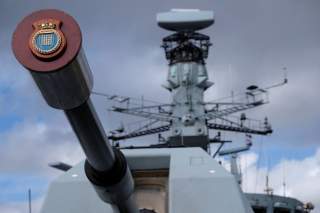The British Royal Navy Just Might Get Some New Frigates After All
A big deal for needy shipbuilders.
The Royal Navy may already have identified a possible replacement for its Type 45 destroyers. A version of the new Type 26 frigate, which should enter service with the U.K. fleet in the mid-2020s, ultimately could replace the air-defense-optimized Type 45s beginning in the 2030s.
The prospect of developing an air-defense variant of the Type 26 offers some hope to the United Kingdom’s beleaguered naval shipbuilders that they might be able to build a large number of ships of different classes without a long break in production.
Trade publication U.K. Defense Journal first reported the possible plan for a new destroyer. The magazine cited Paul Sweeney, a member of the U.K. parliament for Glasgow North East in Scotland, where BAE Systems maintains a large naval shipyard. Sweeney himself is former BAE shipbuilder.
“We’ve been told that consideration is already being given to the development of an anti-air warfare variant of the Type 26, a variant that will function as a future replacement for the Type 45 destroyer fleet,” U.K. Defense Journal explained. “The program is currently referred to as T4X.”
The Royal Navy in 2019 possesses just 19 escort ships, including 13 Type 23 frigates and six Type 45s. The Type 23s are general-purpose escorts with an anti-submarine-warfare bent. The Type 45s with their powerful Sampson radars and Sea Viper missiles primarily are air-defense ships.
The U.K. fleet’s two new aircraft carriers each could sail in a battlegroup including a Type 23 and a Type 45.
The Type 45s are not old. The first ships, HMS Daring, entered service in 2009. The sixth and last, HMS Duncan, joined the fleet in 2013. Typically just four of the destroyers actually have crews and are available for deployments. The other two are undergoing refit.
Recently having launched both of its new carriers, the Royal Navy has shifted its focus to acquiring new frigates to replace the 1990s-vintage Type 23s. The plan is to acquire eight new Types 26s and five Type 31s.
BAE Systems is building the 7,000-ton-displacement Type 26s. Babcock, also based in Scotland, is building the slightly smaller Type 31s. Canada and Australia are buying Type 26s and Babcock hopes also to sell Type 31s on the export market. The frigate programs should keep the two shipyards busy through the 2030s.
By then it would be time to begin replacing the Type 45s. If the navy tapped BAE Systems to develop the Type 4X, the company’s yard in Scotland could transition immediately from manufacturing Type 26s to making the new destroyers.
“The Ministry of Defense want to get to a position where there is a constant rolling production line of Type 26/Type 45 successor and a second production line of Type 31e – building both lines permanently,” Sweeney told U.K. Defense Journal. “As older ships leave service or are sold abroad, new vessels enter service.”
It’s an open question whether the Type 26 hull can support the radar and missiles that a destroyer would require. A Type 45 displaces around 9,000 tons of water owing to the weight of the Sampson radar and 48 vertical launch cells for Sea Viper missiles.
Sweeney for one thinks there’s no problem. “The Type 26 is of sufficient beam to be fitted with a tall Sampson-type … radar mast – especially given the latest composite design options – so there is the basis to have a common hull type and family of ships.”
Cost also is a question. The Type 45s cost a little over a billion dollars apiece. The Type 26s are slightly cheaper than that. But adding a better radar and long-range missiles to a Type 26 hill undoubtedly would increase the cost of the resulting ship.
But U.K. Defense Journal is find of the idea. “A Type 45 destroyer-replacement based on the Type 26 would provide a tangible means to meet the aspiration of continuously producing two standard classes of ships for the Royal Navy, allowing for a more sustainable U.K. shipbuilding industry.”
David Axe serves as Defense Editor of the National Interest. He is the author of the graphic novels War Fix, War Is Boring and Machete Squad.

